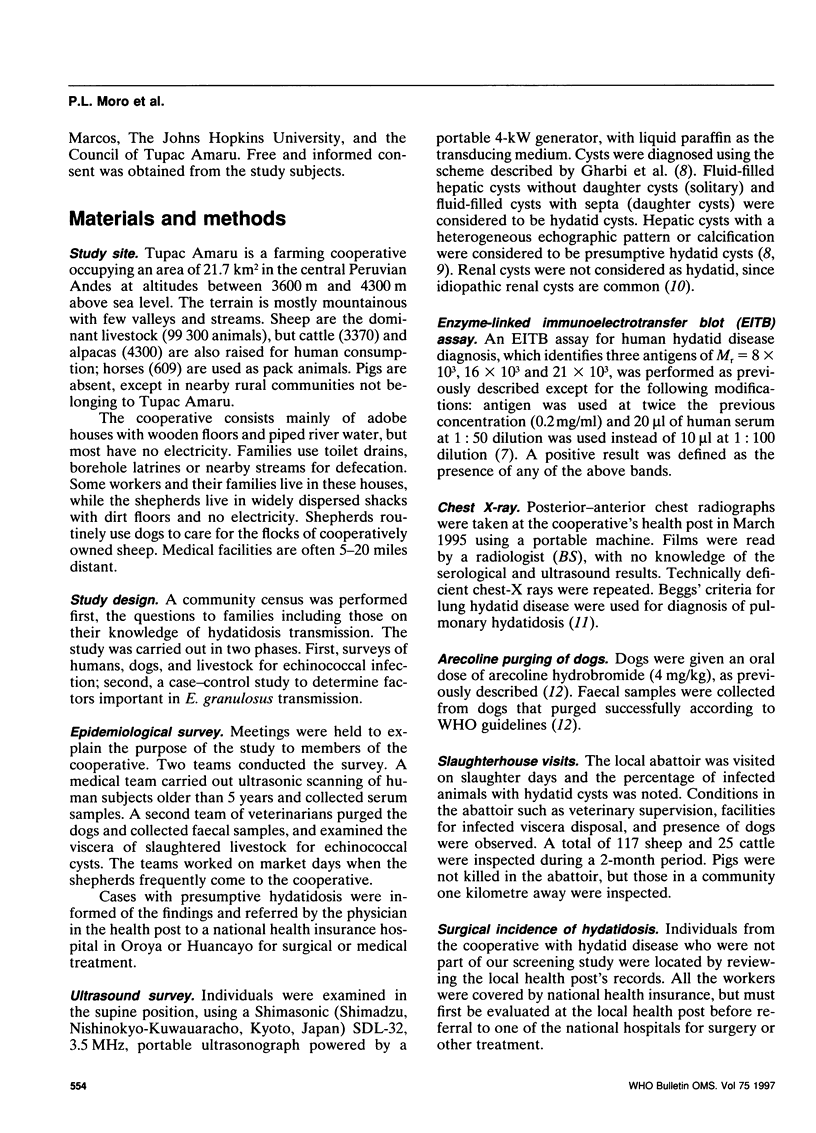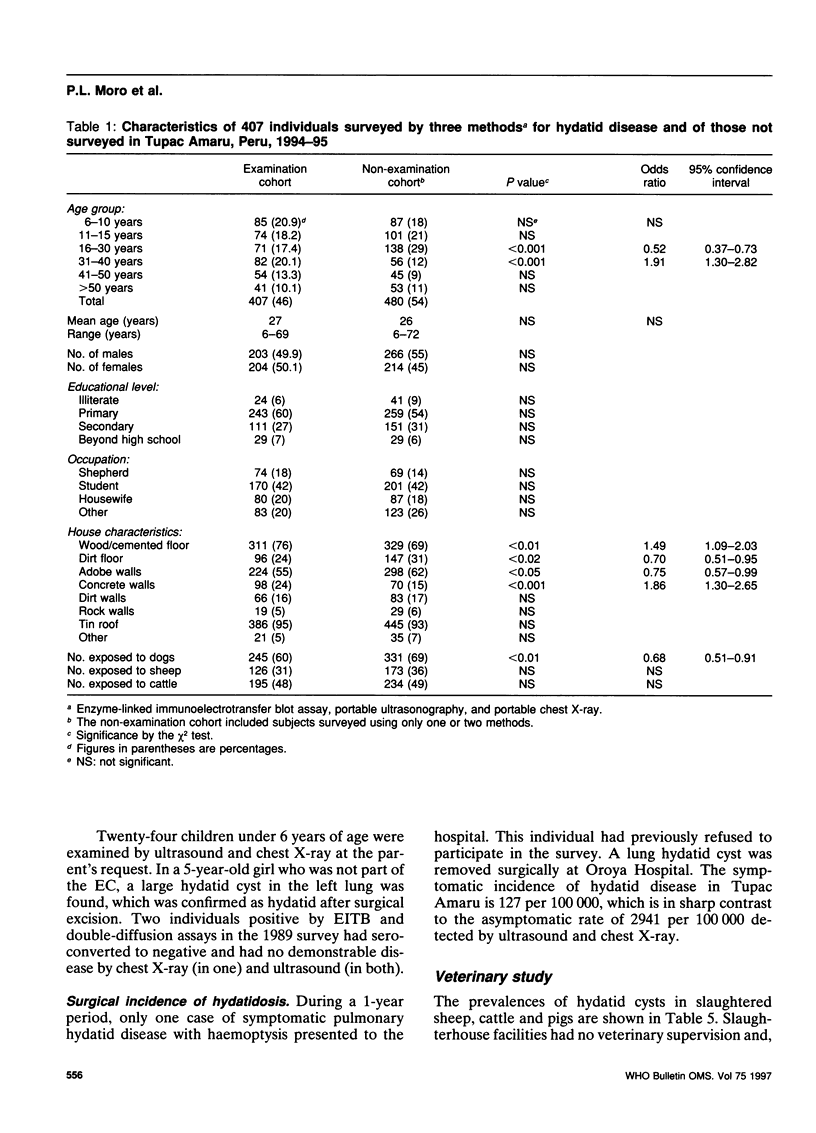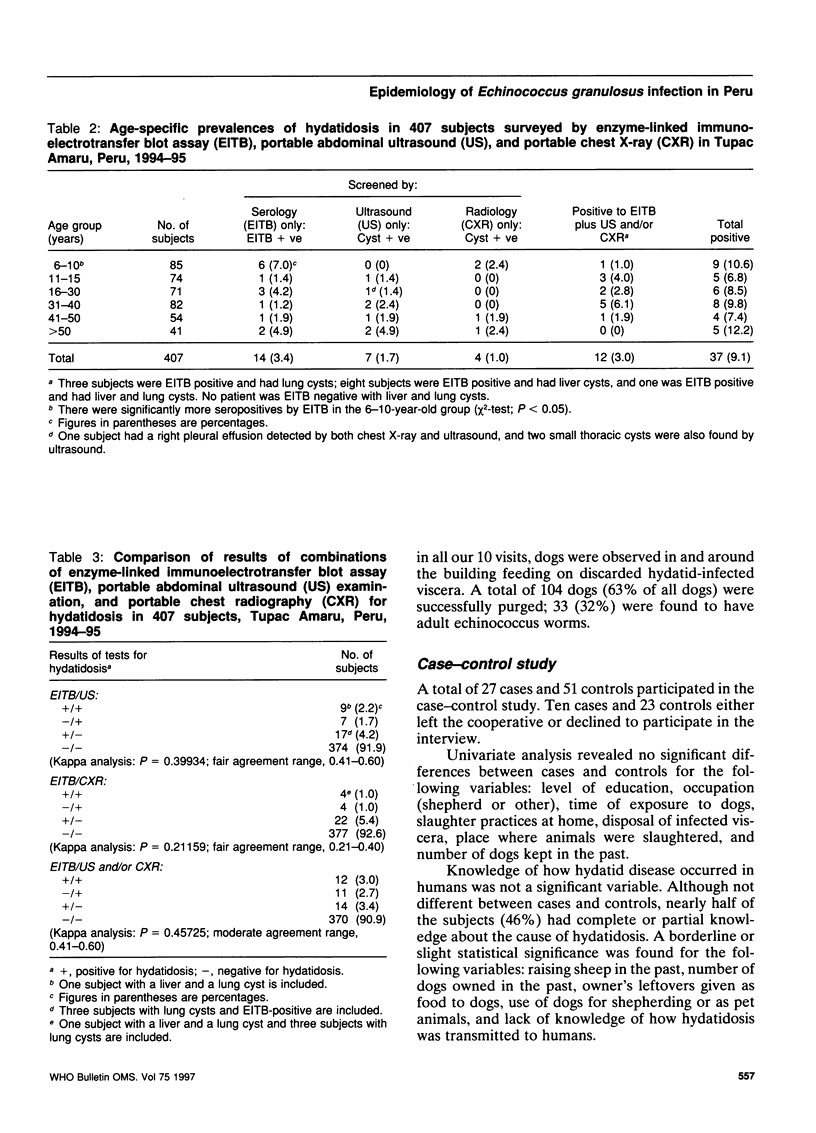Abstract
The prevalence of human, canine, and ovine echinococcosis was determined in an endemic area of the Peruvian Andes where control programmes have not been operational since 1980. Prevalence of infection in humans was determined using portable ultrasound, chest X-rays, and an enzyme-linked immunoelectrotransfer blot (EITB) assay. Canine and ovine echinococcal prevalence was determined by microscopic stool examinations following arecoline purging for tapeworm detection and by examination of the viscera from slaughtered livestock animals, respectively. The prevalence among 407 humans surveyed was 9.1%. The frequency of disease in the liver, lung, and in both organs was 3.4%, 2.0%, and 0.2%, respectively. Portable ultrasound or portable chest X-ray has shown that, compared to adults, children under 11 years had significantly higher seropositive rates without evidence of hydatid disease (P < 0.05). Among the 104 dogs inspected for echinococcus after arecoline purging, 33 (32%) were positive for adult tapeworms. Among the 117 sheep slaughtered at the local abattoir, 102 (87%) had hydatid cysts. The prevalence of human hydatidosis in this endemic area of Peru is one of the highest in the world and nearly five times higher than previously reported in 1980. An increase in echinococcosis prevalence may result after premature cessation of control programmes.
Full text
PDF








Selected References
These references are in PubMed. This may not be the complete list of references from this article.
- Barbieri M., Severi M. A., Pírez M. I., Battistoni J., Nieto A. Use of specific antibody and circulating antigen serum levels in the hydatid immunodiagnosis of asymptomatic population. Int J Parasitol. 1994 Nov;24(7):937–942. doi: 10.1016/0020-7519(94)90157-0. [DOI] [PubMed] [Google Scholar]
- Beggs I. The radiology of hydatid disease. AJR Am J Roentgenol. 1985 Sep;145(3):639–648. doi: 10.2214/ajr.145.3.639. [DOI] [PubMed] [Google Scholar]
- Craig P. S., Zeyhle E., Romig T. Hydatid disease: research and control in Turkana. II. The role of immunological techniques for the diagnosis of hydatid disease. Trans R Soc Trop Med Hyg. 1986;80(2):183–192. doi: 10.1016/0035-9203(86)90003-9. [DOI] [PubMed] [Google Scholar]
- Frider B., Larrieu E., Vargas F., Odriozzola M., Lester R. Catastro ecográfico, serológico y radiológico en hidatidosis humana. Aporte a un programa de control. Acta Gastroenterol Latinoam. 1985;15(4):199–211. [PubMed] [Google Scholar]
- Gharbi H. A., Hassine W., Brauner M. W., Dupuch K. Ultrasound examination of the hydatic liver. Radiology. 1981 May;139(2):459–463. doi: 10.1148/radiology.139.2.7220891. [DOI] [PubMed] [Google Scholar]
- Lahiri S. Physiological responses and adaptations to high altitude. Int Rev Physiol. 1977;15:217–251. [PubMed] [Google Scholar]
- Larrieu E., Frider B., Andreani G., Andreani G., Aquino A., De La Fuente R. Hidatidosis humana: ecografía de campo para la determinación de grupos de alto riesgo en la evaluación de un programa de control. Rev Inst Med Trop Sao Paulo. 1989 Jul-Aug;31(4):267–270. doi: 10.1590/s0036-46651989000400010. [DOI] [PubMed] [Google Scholar]
- MacPherson C. N., Romig T., Zeyhle E., Rees P. H., Were J. B. Portable ultrasound scanner versus serology in screening for hydatid cysts in a nomadic population. Lancet. 1987 Aug 1;2(8553):259–261. doi: 10.1016/s0140-6736(87)90839-7. [DOI] [PubMed] [Google Scholar]
- Moro P. L., Guevara A., Verastegui M., Gilman R. H., Poma H., Tapia B., Tsang V. C., Garcia H. H., Pacheco R., Lapel C. Distribution of hydatidosis and cysticercosis in different Peruvian populations as demonstrated by an enzyme-linked immunoelectrotransfer blot (EITB) assay. The Cysticercosis Working Group in Peru (CWG). Am J Trop Med Hyg. 1994 Dec;51(6):851–855. doi: 10.4269/ajtmh.1994.51.851. [DOI] [PubMed] [Google Scholar]
- Otárola Salcedo G. Epidemiología de la hidatidosis en el Perú. Bol Oficina Sanit Panam. 1966 Feb;60(2):144–153. [PubMed] [Google Scholar]
- Pant C. S., Gupta R. K. Diagnostic value of ultrasonography in hydatid disease in abdomen and chest. Acta Radiol. 1987 Nov-Dec;28(6):743–745. [PubMed] [Google Scholar]
- Perdomo R., Alvarez C., Geninazzi H., Ferreira C., Monti J., Parada R., Jr, Cativelli D., Barrague A. D., Rivero E., Pararda J. Early diagnosis of hydatidosis by ultrasonography. Lancet. 1988 Jan 30;1(8579):244–244. doi: 10.1016/s0140-6736(88)91097-5. [DOI] [PubMed] [Google Scholar]
- Schenone H., Rojas A., Ramírez R. Frecuencia de hidatidosis en autopsias efectuadas en el Instituo de Medicina Legal y 8 hospitales de Santiago, Chile (1947-1970. Bol Chil Parasitol. 1971 Jul-Dec;26(3):98–103. [PubMed] [Google Scholar]
- ZAPATEL J., GUERRERO C., ESCALANTE J. [Hydatidosis in Peru]. Bol Oficina Sanit Panam. 1962 Apr;52:296–308. [PubMed] [Google Scholar]


